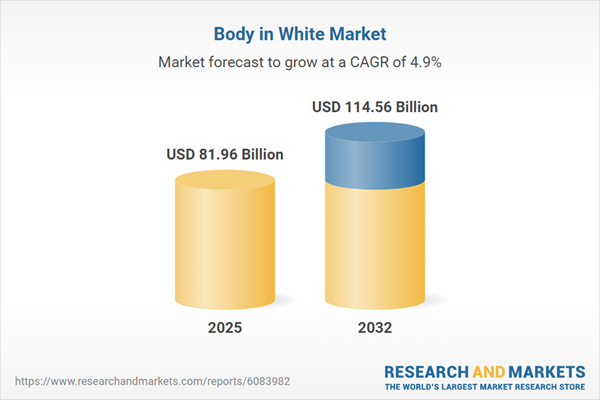Speak directly to the analyst to clarify any post sales queries you may have.
The Body in White market is at a critical inflection point within the automotive sector, as evolving technologies, supply chain adaptations, and shifting regulatory demands steer manufacturers toward decisive innovation and operational agility. Senior leaders will find this analysis essential for anticipating market shifts and leading transformative growth strategies.
Market Snapshot: Body in White Market Size and Growth
The global Body in White market advanced from USD 78.08 billion in 2024 to USD 81.96 billion in 2025, maintaining a compound annual growth rate (CAGR) of 4.90%. By 2032, the market is forecast to reach USD 114.56 billion. Expansion is underpinned by increasing regulatory pressure on vehicle emissions and safety, ongoing advancements in lightweight material adoption, and the proliferation of innovative automotive manufacturing processes. The interplay of process innovation, material science, and evolving consumer expectations establishes a dynamic environment requiring continuous adaptation from market participants.
Scope & Segmentation
This report delivers comprehensive segmentation designed to equip executives with clarity on emerging business opportunities, competitive dynamics, and investment allocation across the Body in White sector:
- Material Types: Includes aluminum variants (Cast Aluminum, Wrought Aluminum) and steel categories (Advanced High Strength Steel, High Strength Steel, Mild Steel), each offering distinct advantages in cost, durability, and weight reduction strategies.
- Vehicle Types: Spans commercial vehicles and passenger cars, reflecting how manufacturers balance structural demands and efficiency mandates across diverse applications.
- Production Processes: Covers the core steps of sealing and coating (E Coating, Primer Coating, Adhesive Sealing, Mechanical Sealing), stamping (Cold Stamping, Hot Stamping), and multiple welding techniques (Arc Welding, Laser Welding, Spot Welding), supporting improvements in efficiency, precision, and product longevity.
- Regions: Detailed geographic analysis captures the Americas (with distinct profiles for North America—United States, Canada, Mexico and Latin America—Brazil, Argentina, Chile, Colombia, Peru), Europe, Middle East & Africa (United Kingdom, Germany, France, Russia, Italy, Spain, Netherlands, Sweden, Poland, Switzerland, United Arab Emirates, Saudi Arabia, Qatar, Turkey, Israel, South Africa, Nigeria, Egypt, Kenya), and Asia-Pacific (China, India, Japan, Australia, South Korea, Indonesia, Thailand, Malaysia, Singapore, Taiwan), enabling granular benchmarking and opportunity identification.
- Key Companies: The competitive landscape features leading players such as Magna International Inc., Gestamp Automoción S.A., Martinrea International Inc., Benteler International AG, ArcelorMittal S.A., Novelis Inc., Shiloh Industries Inc., Bharat Forge Limited, HBPO GmbH, and Autokiniton US Holdings Inc., each contributing to material innovation and value chain agility.
Key Takeaways for Strategy Leaders
- Widespread adoption of advanced high strength steels and novel aluminum alloys is enabling reductions in vehicle mass and increases in structural safety, supporting both regulatory compliance and market differentiation.
- Manufacturers are embracing factory-floor flexibility, investing in modular stamping and welding systems to accelerate adaptation for electric and autonomous platforms across multiple vehicle classes.
- New approaches to sealing and coating focus on sustainability, emphasizing processes and materials that reduce lifecycle environmental impacts and support end-of-life recyclability.
- Automotive OEMs and component suppliers are increasingly consolidating and localizing procurement activities, shielding operations from tariff exposure and enabling greater control over material supply continuity.
- Vehicle design strategies differ significantly by segment, with commercial vehicles prioritizing robust endurance while passenger cars seek maximized energy efficiency through light-weighting and process optimization.
- Incremental collaboration among OEMs, Tier-1 suppliers, and R&D partners is fostering quicker technology integration and more reliable quality assurance, fueling innovation across the entire supply chain.
Tariff Impact on Supply Chain Strategy
Recent changes in United States tariff policy are reshaping the Body in White supply chain. Increased import duties on targeted steel and aluminum grades have encouraged market participants to localize their supplier networks and escalate in-region production capacity. As a result, companies are innovating in materials protection and assembly techniques, while maintaining close control of lifecycle costs. These shifts emphasize collaborative research, production modernization, and agile localization to help protect competitive cost structures and ensure ongoing market access despite regulatory volatility.
Methodology & Data Sources
This Body in White market analysis employs a structured research approach incorporating secondary literature review, in-depth qualitative interviews with stakeholders from OEMs, suppliers, and academic experts, and additional validation through advisory board assessment. Harmonization of data streams guarantees a cohesive understanding from technical, operational, and broader market vantage points.
Why This Report Matters for Decision-Makers
- Enables clear identification of material and process trends that directly influence competitiveness and long-term strategic planning initiatives.
- Empowers leadership teams with actionable intelligence to drive targeted technology integration, process improvement, and expansion across promising regional markets.
Conclusion
Strategic material choices, adaptive manufacturing, and cross-value chain collaboration now define the Body in White market. Equipped with the right insights, senior executives can steer operational transformation and sustain organizational relevance amidst evolving automotive industry demands.
Table of Contents
3. Executive Summary
4. Market Overview
7. Cumulative Impact of Artificial Intelligence 2025
Companies Mentioned
The companies profiled in this Body in White market report include:- Magna International Inc.
- Gestamp Automoción, S.A.
- Martinrea International Inc.
- Benteler International AG
- ArcelorMittal S.A.
- Novelis Inc.
- Shiloh Industries, Inc.
- Bharat Forge Limited
- HBPO GmbH
- Autokiniton US Holdings, Inc.
Table Information
| Report Attribute | Details |
|---|---|
| No. of Pages | 189 |
| Published | October 2025 |
| Forecast Period | 2025 - 2032 |
| Estimated Market Value ( USD | $ 81.96 Billion |
| Forecasted Market Value ( USD | $ 114.56 Billion |
| Compound Annual Growth Rate | 4.9% |
| Regions Covered | Global |
| No. of Companies Mentioned | 11 |









